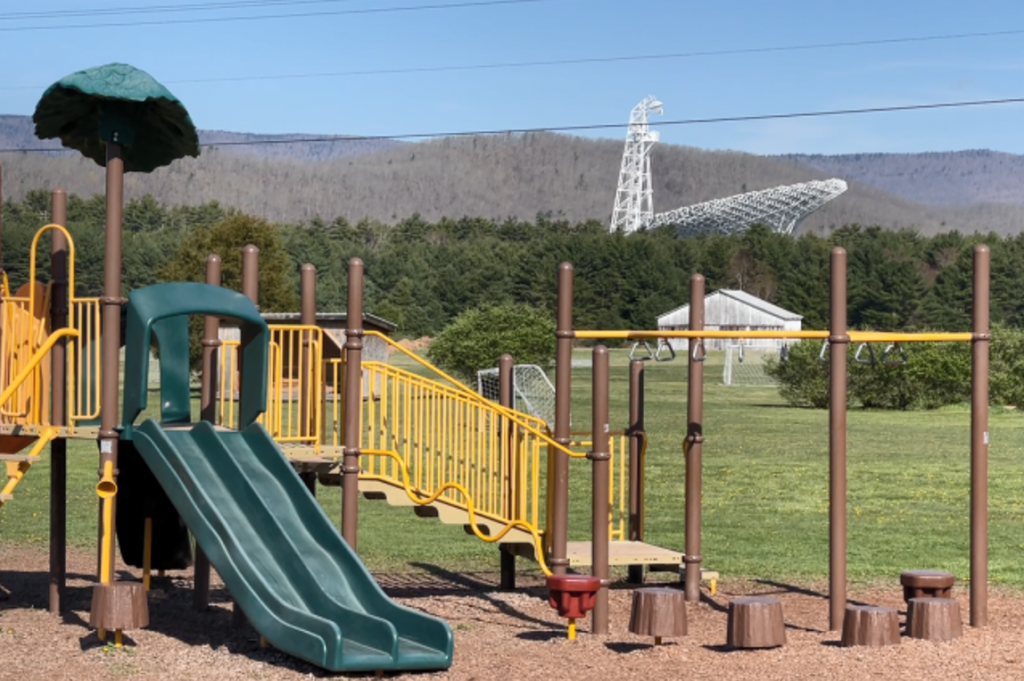The U.S. National Science Foundation National Radio Astronomy Observatory (NSF NRAO), in partnership with several leading Mexican universities and research institutes, has announced a series of landmark agreements and meetings aimed at advancing Mexico’s role in the Next Generation Very Large Array (ngVLA) project.
Recent News
Astronomers Discover a Superheated Star Factory in the Early Universe
Astronomers have uncovered a previously unknown, extreme kind of star factory by taking the temperature of a distant galaxy using the ALMA telescope. The galaxy is glowing intensely in superheated cosmic dust while forming stars 180 times faster than our own Milky Way.
Astronomers Share Largest Molecular Survey To-date: GOTHAM Legacy Data Goes Public
Astronomers in the “GBT Observations of TMC-1: Hunting Aromatic Molecules” research survey, known as GOTHAM, have released a spectral line survey with largest amount of telescope time ever conducted, charting more than 100 molecular species only found in deep space.
NSF Green Bank Observatory Works with Local School to Allow WiFi in the ‘Quiet Zone’

The U.S. National Science Foundation Green Bank Observatory (NSF GBO) is entering a new era for the “Quiet Zone”— allowing the use of WiFi at the Green Bank Elementary and Middle School, which sits next door to the NSF Green Bank Telescope.
The Observatory exists within two “Quiet Zones” that protect its scientific research: the 13,000-square-mile National Radio Quiet Zone (NRQZ) that exists across large areas of West Virginia and Virginia, and the much smaller West Virginia Radio Astronomy Zone (WVRAZ) that provides guidelines for a 10-mile radius surrounding the Observatory.
Up until now, the WVRAZ has prohibited the use of devices that create emissions— like WiFi routers—in this area.
“This is a big, positive change for us,” shares GBEMS Principal Melissa Jordan, “This conversation has been going on for a few years, and it’s finally happening.” The Pocahontas County Schools have five locations, and GBEMS (with its location in the WVRAZ) was the only school without WiFi. “Our students now have the same equal opportunities as the others in the county. We’re really excited to see the ways that this can positively impact student achievement.”
When the Observatory was founded in 1956 by the NSF National Radio Astronomy Observatory it was the first national observatory in the United States, created to be a resource for scientists across the country. The Quiet Zones were also established around this time to protect this important work. The Observatory donated land and helped establish several public services for the surrounding community, including the school and library, for the benefit of all residents. At that time, no one could have foreseen the evolution of education, and how today’s classrooms use WiFi as a fundamental part of student learning.
“When these Quiet Zones were created in the late 1950s, by the Federal Communications Commission and the state of West Virginia, officials could not have predicted the technology using radio wavelengths that are almost an essential part of our daily lives,” shares Anthony Remijan, director of the NSF GBO. “Today, we’re trying to balance our scientific operations with the reality of a world with WiFi.”
The WVRAZ is enforced primarily through voluntary compliance: residents who are aware of the restrictions follow them—however, this has not prevented some residents and business owners from installing and using Wi-Fi routers, some for over a decade. Monitoring and enforcement of the Quiet Zones has been limited by Observatory operating budgets and staff availability. It can also be difficult to pinpoint specific sources of interference, with reports of over 100 signals detected in the area surrounding the Observatory.
When observing, the NSF GBT operates 24 hours a day. The radio frequencies that WiFi use to connect with phones, tablets, and other devices are the same type of wavelengths emitted by objects in space. When WiFi is on at the same time, these frequencies overlap—and hide—what the scientists are looking for.
Specifically, scientists observing in S-band (2–4 GHz) with NSF Green Bank Telescope are the most affected by WiFi operating at 2.4 GHz. However, this is one of the easiest and most accessible wavelengths for WiFi routers to operate at, especially those that can be bought off the shelf in the greater area, at a reasonable price. After reviewing many scenarios considering other wavelengths, Observatory engineers and scientists felt that the best compromise, for the benefit of the local community, was to use this specific wavelength, which was already impacted by the unapproved use of many WiFi routers in the area. “Many people who were doing the right thing by not using WiFi were left without access, while others who were illegally using routers did whatever they wanted,” Remijan explains. “Now, the Observatory is offering guidance that benefits everyone and helps us better manage the situation.”
The hope is that these new guidelines will encourage locals to make the switch, and adjust their router settings to prevent overlap with other frequencies, essentially directing all the interference to this one specific frequency. “Scientists observing at this frequency have been working with this problem for years. They’ve still been able to get data for their research, it’s just harder to do, another challenge to tackle,” adds Remijan, who has used the NSF Green Bank Telescope many times over his scientific career.
“Updating our policy and permitting WiFi at 2.4 GHz in the WVRAZ allows us to be realistic about what’s happening around the Observatory, and clearly define what areas of Radio Frequency Interference our staff should be focused on,” adds Chris De Pree, head of NRAO’s Spectrum Management Department. “Today, some of our biggest interference is coming from the sky, and we’re working closely with satellite phone and internet providers to develop systems to keep those signals away from our telescopes.”
This change has had the support of West Virginia elected officials, including Senator Shelley Moore Capito, “GBO’s gift to Green Bank Elementary School is not just of WiFi, but the gift of education, inspiration and knowledge. Enabling the students this tool to expand their universe is a fitting thing to receive from the Green Bank Observatory. While GBO studies the stars, I applaud them for their commitment to the neighbors here on earth. I hope the students are excited to have the tools to help them become the scientists and explorers of tomorrow.”
“Being so close to the Observatory, we’ve had a good partnership that’s brought new opportunities for our students, from field trips, to student contact with the International Space Station, and student science with weather balloons,” adds GBEMS Assistant Principal Chloe Schaffner, “We have a good partnership, and it’s great that it’s led to this change.”
The NSF Green Bank Observatory is sharing guidance on how local residents can set up their routers to operate at 2.4GHz. This information is available at their website, along with handouts that can be picked up at the Green Bank Science Center. Information will also be available at the Green Bank Library, and school. Observatory staff have presented this information to the Pocahontas County School Board, along with upcoming presentations for teachers, students, and parents. Community presentations will also be held at the Observatory and at locations in the surrounding community this August and September.
This news article was originally published on the NRAO website on August 6, 2025.
Recent News
NSF National Radio Astronomy Observatory and Mexican Institutions Sign Historic Agreements to Advance ngVLA Collaboration
The U.S. National Science Foundation National Radio Astronomy Observatory (NSF NRAO), in partnership with several leading Mexican universities and research institutes, has announced a series of landmark agreements and meetings aimed at advancing Mexico’s role in the Next Generation Very Large Array (ngVLA) project.
Astronomers Discover a Superheated Star Factory in the Early Universe
Astronomers have uncovered a previously unknown, extreme kind of star factory by taking the temperature of a distant galaxy using the ALMA telescope. The galaxy is glowing intensely in superheated cosmic dust while forming stars 180 times faster than our own Milky Way.
Astronomers Share Largest Molecular Survey To-date: GOTHAM Legacy Data Goes Public
Astronomers in the “GBT Observations of TMC-1: Hunting Aromatic Molecules” research survey, known as GOTHAM, have released a spectral line survey with largest amount of telescope time ever conducted, charting more than 100 molecular species only found in deep space.
